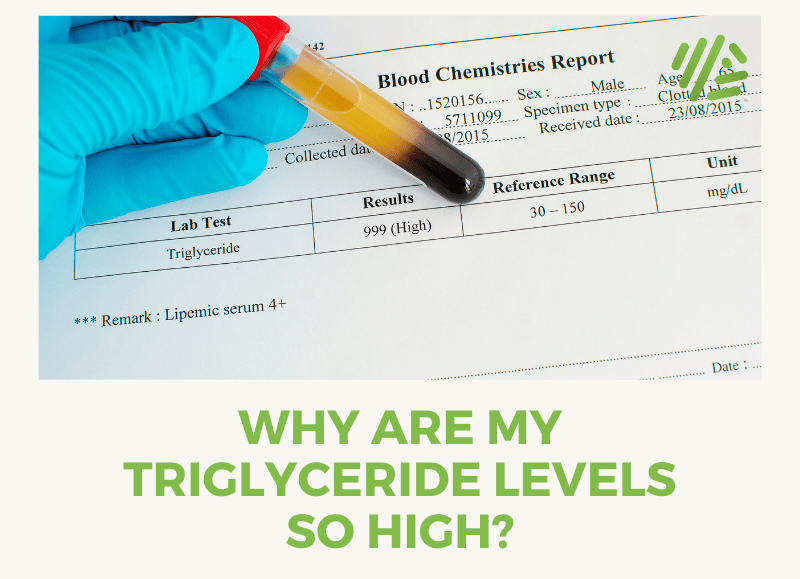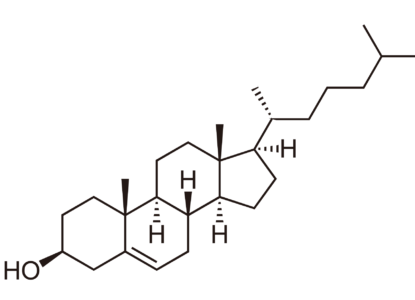Why are my Triglyceride Levels so High?

Contents
- What are triglycerides?
- Rethinking the 150 mg/dL triglyceride threshold
- The problem with high TGs
- What causes high triglycerides?
- Plant-based diets and triglycerides
- Strategies for lowering TG
- Other causes of high triglycerides
- Your genes and triglycerides
- Triglycerides and HDL – what’s the link?
- When to get your TGs tested?
If you just got your blood work back, maybe you’re asking, “Why are my Triglyceride levels so high?”
Chances are, it’s because of your diet and lifestyle.
This is good news!
It means you have a great opportunity to make some quick changes and get those lipids in line. There are a few other potential reasons for elevated triglycerides, such as a genetic predisposition. I touch on these below, but bear in mind that these factors are far less likely to be the primary culprit for high TGs.
What are triglycerides?
Before we dig in, a quick refresher. Triglycerides (hereafter simply “TG”) are a type of lipid made up of a glycerol molecule bound to three fatty acids.
The body creates triglycerides as a way of storing unused calories. So, if your overall energy intake consistently exceeds your energy expenditure, you’re likely to have high triglyceride levels and increased fat stores.
Why does this matter? Well, because a high TG result, especially if you have low HDL, puts you at greater risk for a heart attack or stroke.
Rethinking the 150 mg/dL triglyceride threshold
What are normal levels of triglycerides? Most labs define “High TG” as fasting levels greater > 150 mg/dL. However, new research published in the August, 2020 edition of the Journal of Clinical Lipidology suggests physicians might want to take a more aggressive stance when lowering TGs in their patients. To quote the Journal:
the association of TGs and CVD risk continued well below TG levels of 150 mg/dL. This supports the American Heart Association’s statement that an optimal “fasting” TG level is less than 100 mg/dL and further suggests that an optimal level may be even lower.
The trend in measuring TGs seems to be averaging levels over several days rather than using one fasted blood draw to gauge a healthy metabolism.
The problem with high TGs
If your TG level is persistently above 175 mg/dL, this is known as hypertriglyceridemia. Such high levels increase your risk of diabetes, heart disease, and other health issues. In one study involving just under 400 people with an average age of 57, coronary artery disease was more pronounced in those with abnormal TG levels. 1
Elevated levels of triglycerides contribute to arteriosclerosis, where arteries become thicker and harder. Arteriosclerosis means that your arteries are less responsive, making it harder for your body to maintain normal blood pressure or respond safely to demands for increased circulation (such as during exercise).
If your triglycerides are super high, this also increases you risk of acute pancreatic inflammation (pancreatitis). High TGs might also prompt your doctor to look at your blood pressure, blood sugar, central adiposity (i.e. fat around your waistline), and levels of other blood lipids. This is because high triglycerides are one factor in metabolic syndrome and may indicate pre-diabetes or type 2 diabetes.
What causes high triglycerides?
Diet and lifestyle factors are key drivers of elevated triglycerides. A high-carbohydrate diet, lack of exercise, and high stress levels can all contribute to increased insulin resistance, which means higher blood sugar levels and greater triglyceride production.
Think about it, if you eat a meal or snack that contains a lot of energy in the form of sugar, but you don’t burn off that energy through physical activity, your body has to put it somewhere. That means your liver works overtime to create triglycerides as a way to store that energy. Your pancreas also has to work harder to produce insulin to help get all this excess sugar into cells.
If this situation persists, your triglyceride levels will continue to be elevated. Your fat stores will also increase and your body’s cells will get tired of being bathed in insulin and start ignoring the chemical messenger. This makes it harder and harder to clear sugar from the blood, resulting in hyperglycemia (elevated blood sugar) and hypertriglyceridemia (elevated triglycerides). Eventually, your pancreatic beta-cells that produce insulin burn out, leading to full-blown type 2 diabetes.
Clearly this isn’t an ideal situation. But there is good news. Cutting back on your intake of refined carbohydrates and getting more exercise can reverse insulin resistance. It also helps reduce triglycerides, meaning a lower risk of type 2 diabetes, metabolic disease, and cardiovascular disease.
Plant-based diets and triglycerides
Do vegans have higher triglycerides?
One meta-analysis of some 30 observational studies and 19 clinical trials concluded that while a vegetarian diet was associated with lower levels of total cholesterol and LDL-C, as well as HDL-C, compared to an omnivorous diet, triglycerides may actually increase when switching to a plant-based diet. 2
Interestingly, triglycerides were still found to be lower on average in the observational studies (by 6.5 mg/dL), but higher by 5.8 mg/dL in interventional studies (i.e. where people were put on a vegetarian diet). Why might this be? Well, speaking from experience, it’s pretty easy to load up on carbs when getting used to a vegetarian or vegan diet. This is, in part, because the ‘vegan’ option when eating out is often just the meat or vegetarian dish minus the major sources of protein and fat. So much so that I often carry high-protein and high-fat snacks with me when I know there’ll be few, if any, balanced vegan meal choices.
What else can you do to mitigate the triglyceride-raising effects of a high-carb diet?
Three quick ideas are: 3
- Increasing your physical activity – engage in resistance training and reduce sedentary time
- Take an omega-3 fatty acid supplement (fish oil or algal oil)
- Choose fiber-rich, low glycemic index whole foods instead of processed, refined carbs.
If your triglycerides are high, skip the simple carbs
To really spell it out, if you have high TGs, you’ll want to skip the simple carbohydrates. That means cutting down on sugar and foods made with refined grains (such as white flour), as well as fructose (such as in condiments). These types of foods can all increase triglycerides, as can alcohol.
Alcohol can raise TG levels
That’s right, even though splashy news headlines like to say that a glass of wine a day can boost HDL levels, the sugar (ethanol) in booze can also raise your TG levels. So, sure, go ahead and enjoy that glass of wine, just don’t raise so many glasses that you also raise your triglycerides.
Note: when we asked world renowned lipidologist Dr. Dayspring about alcohol and TG levels, he didn’t believe alcohol plays a big role in most people.
Strategies for lowering TG
Guidelines suggest that adults aged 20 or older with moderate hypertriglyceridemia (TG of 175-499 mg/dL) should first address lifestyle factors such as obesity and metabolic syndrome. It’s also important to look at secondary factors such as diabetes mellitus, chronic liver or kidney disease, nephrotic syndrome, and hypothyroidism, as well as medications that increase triglycerides. 4
Severe hypertriglyceridemia warrants a more robust response. So, if your fasting triglycerides are 500 mg/dL or higher, guidelines suggest:
- Eating a very low-fat diet (just don’t replace fats with high-carb foods!)
- Avoiding refined carbohydrates and alcohol
- Increasing omega-3 fatty acids
- Fibrate therapy (to prevent acute pancreatitis).
Other causes of high triglycerides
High TGs are typically caused by diet and lifestyle. In some cases, however, high triglycerides can result from genetic polymorphisms that affect how your body converts fat into energy (see below).
High TG levels may also be traced back to an underactive thyroid (hypothyroidism). If you’re a woman in her mid-thirties to forties, and/or have just had a baby, changes in thyroid function are pretty common. A good family doctor will usually suggest a full thyroid panel around this age. If not, consider requesting a check-up, particularly for TSH (thyroid stimulating hormone).
A whole raft of drugs can also affect triglyceride levels. These include:
- Diuretics
- Oral contraceptive and hormone replacement therapy (specifically estrogen and progestin)
- Retinoids (often used for acne)
- Steroids (oral or injected)
- Beta blockers
- Some immunosuppressants
- Some antiretrovirals / HIV medications.
To be clear, I’m in no way suggesting that you should stop taking any such medications if your test results show high TG levels. Instead, talk to your health care practitioner for guidance on how to manage TG levels alongside any other medical conditions for which you’re taking medications.
Your genes and triglycerides
For people with certain genetic variants, the process of atherosclerosis may start quite early in life. Heart disease is typically associated with middle age and later life, but how your body handles cholesterol determines when arterial plaque begins to build up.
Some of the genes and gene variants thought to influence your TG levels include 5:
- TRIB1
- GCKR.
TRIB1 TA and AA genotypes were associated with higher TG levels compared to TT genotypes in one analysis. TA and AA genotypes also tended to have higher remnant cholesterol, apolipoprotein B, and LDL-C, and lower HDL-C. This analysis also noted that TRIB1 TA and AA genotypes had a 13% and 15% increased risk of ischemic heart disease (IHD) and an 11% and 17% increased risk of myocardial infarction (MI, or heart attack). 6
The same analysis found that GCKR CT and TT genotypes had higher TGs, remnant cholesterol, and apoB compared to CC genotypes, but that this gene didn’t seem to affect levels of LDL-C or the risk of IHD or MI.
Knowing if you carry any gene variants that might alter how your body produces and metabolizes triglycerides could help you take steps to keep triglycerides in check.
Triglycerides and HDL – what’s the link?
When triglycerides are consistently elevated, a whole load of that excess fat and sugar ends up stored in the liver. This compromises liver function, which means the liver is less able to create high-density lipoprotein (HDL). This condition is known as diabetic atherogenic dyslipidemia.
As the name suggests, when this condition arises lipids are so out of balance that they contribute to undesirable changes in arteries. This primarly means atherosclerosis, which increase the risk of heart attack and stroke.
High-density lipoprotein (HDL) is commonly called ‘good’ cholesterol. This larger lipid picks up excess cholesterol in the blood and transports it to the liver, where it is broken down and removed from your body. So, it stands to reason that you’ll want more HDL than you do TGs circulating in your blood.
Lowering your TG levels has more than just a direct benefit for cardiovascular health, then. It can also indirectly benefit your arteries by supporting better HDL production. Indeed, coronary artery disease was twice as likely to be extensive in those with an abnormal TG:HDL ratio in one study. 1
Even in a person who seems neurologically healthy, a poor TG:HDL ratio may raise the risk of stroke. In one 2019 study, for example, 8.3% of more than 3,000 healthy participants had silent brain infarcts (SBI). Those with a high TG:HDL ratio were 16% more likely to have an SBI. This is a subclinical pathology commonly seen prior to ischemic stroke, especially in older adults. 7
There’s another link between TG and HDL. Larger, less dense HDL2 particles are considered protective and inversely correlate with TG levels and small, dense, LDL particles. So, the lower your levels of HDL2, the higher your TG and LDL tends to be. 8
Working out your TG to HDL ratio
Note: as we discussed on a recent episode of the podcast, TG:HDL ratio has very little meaning for the Black community because African Americans are much less likely to have elevated TG, even in the presence of insulin resistance.
If you’ve just undergone a fasting lipid panel, you might see results for ‘TG:HDL’ listed alongside total cholesterol and LDL cholesterol. If not, you can work out your TG:HDL ratio for yourself. All you have to do is divide the triglyceride count by the HDL count. So, if your TG is 120 mg/dL and your HDL is 60 mg/dL, your TG:HDL ratio is 2.00. As another example, a TG level of 150 mg/dL and HDL of 50 mg/dL gives a TG:HDL of 3.00.
Top tip: Numerical values for TGs and HDL-C are often given in mg/dL and mmol/L. To convert mg/dL to mmol/L, divide the values for HDL-C, by 38.6; for triglycerides, divide by 88.6.
When to get your TGs tested?
The American Heart Association recommends that everyone has a blood cholesterol test by the age of 20. Ideally, this test will include triglycerides. If you are overweight, obese, or considered at risk for heart disease, earlier testing is preferable. Harvard Health suggest getting tested at least every five years after the age of 20.
You might also want to get your labs done if you eat a lot of carbohydrates, have switched to a plant-based diet, lack energy, or have recently gained weight. Knowing your TG levels puts you in a far better position to make positive changes in your diet and lifestyle.



